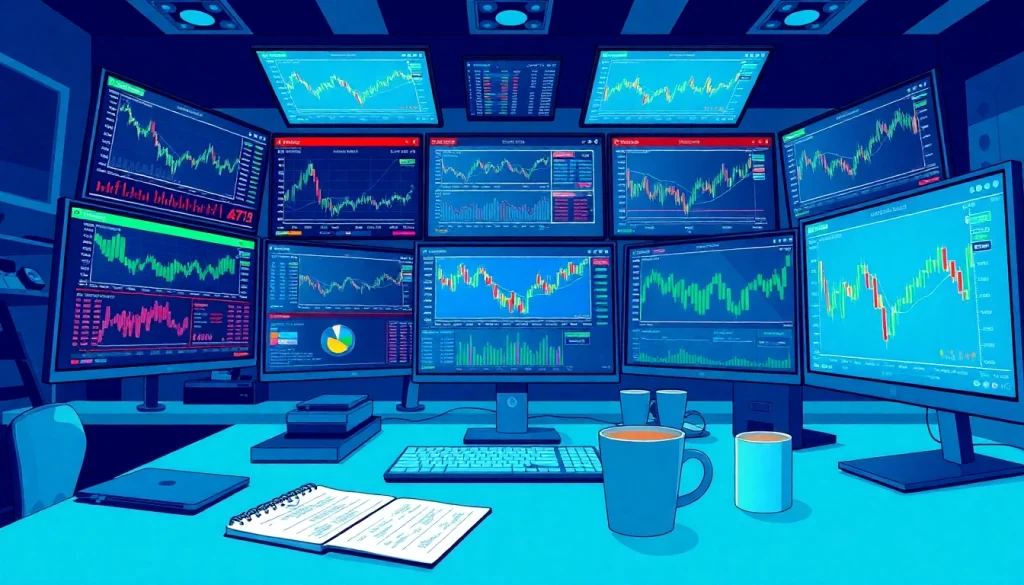
Overview of Trading Tools
What Are Trading Tools?
Trading tools encompass a wide range of software and applications designed to assist traders in making informed buying and selling decisions. These tools serve various functions, from market analysis to risk management, enabling traders to streamline their trading processes and improve their overall performance. Examples include charting software, market scanners, economic calendars, and backtesting tools. By leveraging these resources, traders can analyze market trends, assess risks, and optimize their strategies.
Importance of Using Trading Tools
Using trading tools is critical for both novice and experienced traders for several reasons. Firstly, they enhance market analysis by providing detailed insights into price movements and trading patterns. Secondly, they reduce emotional decision-making by providing data-driven information. Moreover, these tools can automate certain trading processes, which is particularly useful for those who cannot monitor the markets continuously. Overall, the systematic use of trading tools can lead to more strategic and calculated trading decisions.
Types of Trading Tools Available
There is a multitude of trading tools available, each designed for specific functions. Here are some of the most popular categories:
- Charting Tools: These help traders analyze price movements with graphical representations. Software options like TradingView and MetaTrader are particularly popular.
- Market Scanners: Tools that sift through large amounts of data to find potential trading opportunities by screening for particular patterns or trends.
- Economic Calendars: These keep traders updated on important economic events and data releases, allowing them to adjust their strategies accordingly.
- Backtesting Software: This allows traders to test their strategies against historical data to evaluate potential effectiveness before applying them in real trading scenarios.
- News Aggregators: Tools that compile information from various news sources to provide a comprehensive view of market-moving news.
Beginner’s Guide to Trading Tools
Essential Tools for New Traders
For beginners, entering the trading world can be daunting. Fortunately, there are a few essential tools that can greatly simplify the experience:
- Demo Accounts: Practicing trading without risking real money is vital. Many platforms offer demo accounts where new traders can hone their skills.
- Charting Software: Basic charting tools will help beginners understand price movements and patterns. Familiarity with tools like TradingView is crucial.
- News Feed Tools: Keeping abreast of market news using aggregators can give beginners insights into factors affecting market movements.
- Community Forums: Engaging with other traders, especially through forums like Reddit or specialized trading communities, can provide valuable insights and peer support.
How to Choose the Right Trading Tools
Selecting the right trading tools can make a significant difference in a trader’s success. Here are some guidelines to help with the selection process:
- Identify Your Trading Style: Different trading styles—day trading, swing trading, or long-term investing—require different tools. Identify your style first.
- Assess Your Needs: Consider what you need from a tool, whether it’s real-time data, analytical capabilities, or automated trading features.
- Read Reviews: Look for feedback from other traders regarding the effectiveness and reliability of the tools you’re considering.
- Trial Versions: Many tools offer trial periods. Testing them out can help determine if they meet your needs before making a financial commitment.
Common Mistakes to Avoid
New traders often make several common mistakes when it comes to using trading tools:
- Over-reliance on Tools: While tools can provide valuable insights, over-dependence can lead to disregarding personal judgment and intuition.
- Ignoring Market Conditions: Tools are more effective when integrated with an understanding of the current market environment and macroeconomic variables.
- Neglecting Education: Focusing solely on tools without acquiring fundamental knowledge can hinder a trader’s development.
Advanced Trading Tools for Professionals
Leveraging Data Analysis Tools
For professional traders, data analysis tools become imperative for making informed decisions. These tools allow for the in-depth analysis of vast datasets, providing insights into market trends and behaviors. Advanced software solutions can integrate various data streams, enabling traders to identify correlations and potential trading signals that may not be immediately evident. Traders can utilize platforms like Bloomberg Terminal and TradeStation for sophisticated data analysis capabilities.
Utilizing Automated Trading Tools
Automated trading tools have revolutionized the trading landscape. These allow traders to program specific conditions under which trades will automatically be executed. By utilizing algorithms based on technical indicators, traders can minimize emotional trading and maintain discipline. Professional traders often use platforms like NinjaTrader, which supports automated strategies and provides backtesting capabilities.
Integrating Trading Indicators for Better Decisions
Trading indicators are critical components that help traders interpret price movements and market trends. Indicators such as Moving Averages, Bollinger Bands, and Relative Strength Index (RSI) can provide valuable insights into entry and exit points. Understanding how to combine these indicators effectively—as part of a broader trading strategy—can significantly enhance trading outcomes.
Performance Metrics for Trading Tools
Measuring the Effectiveness of Trading Tools
To ensure that trading tools are achieving their intended goals, traders must continually measure their effectiveness. This can be done through various performance metrics that assess how well tools are performing in real market conditions. Common methods include:
- Win Rates: The percentage of winning trades compared to losing ones.
- Return on Investment (ROI): The profit or loss made relative to the amount invested.
- Sharpe Ratio: A measure of risk-adjusted return; higher values indicate better risk management.
Key Performance Indicators to Monitor
Aside from measuring individual tool effectiveness, several key performance indicators (KPIs) can provide insights into overall trading success, such as:
- Average Profit/Loss per Trade: Understanding how much is gained or lost on average can help refine strategies.
- Trade Frequency: Monitoring how often trades are executed and the results can help regulate trading activity, avoiding overtrading.
- Drawdown Levels: Evaluating the maximum decline from a peak to the lowest point to manage risk and psychological endurance.
Adjusting Tools Based on Performance Data
Regular reviews of performance data will help traders identify areas where tools may be underperforming. Adjustments based on concrete feedback can lead to improved efficiencies. This could involve altering settings within tools, trying new features, or even switching to alternative tools that better meet the evolving landscape of trading.
Future of Trading Tools
Emerging Technologies in Trading
The landscape of trading tools is rapidly evolving, largely driven by technological advancements. New technologies such as blockchain, cloud computing, and big data analytics are set to reshape how trading is conducted. Tools that leverage real-time data and provide predictive insights will increasingly dominate the market, offering traders an edge in decision-making.
The Role of AI and Machine Learning
Artificial Intelligence (AI) and machine learning are on the forefront of transforming trading tools. These technologies allow for the analysis of extensive datasets far beyond human capability. AI algorithms can identify patterns and make predictions, allowing traders to be more proactive rather than reactive. Platforms that utilize AI, such as QuantConnect, are paving the way for smarter trading and better risk management.
Preparing for Changes in the Trading Landscape
As the trading landscape continually evolves, traders must remain agile and ready to adapt. Staying informed about the latest trends and advancements in trading technology is crucial. This can involve hands-on experience with new platforms, participating in webinars or industry events, and gaining certifications in advanced trading tools. By being proactive and embracing change, traders can position themselves effectively within an increasingly competitive environment.



